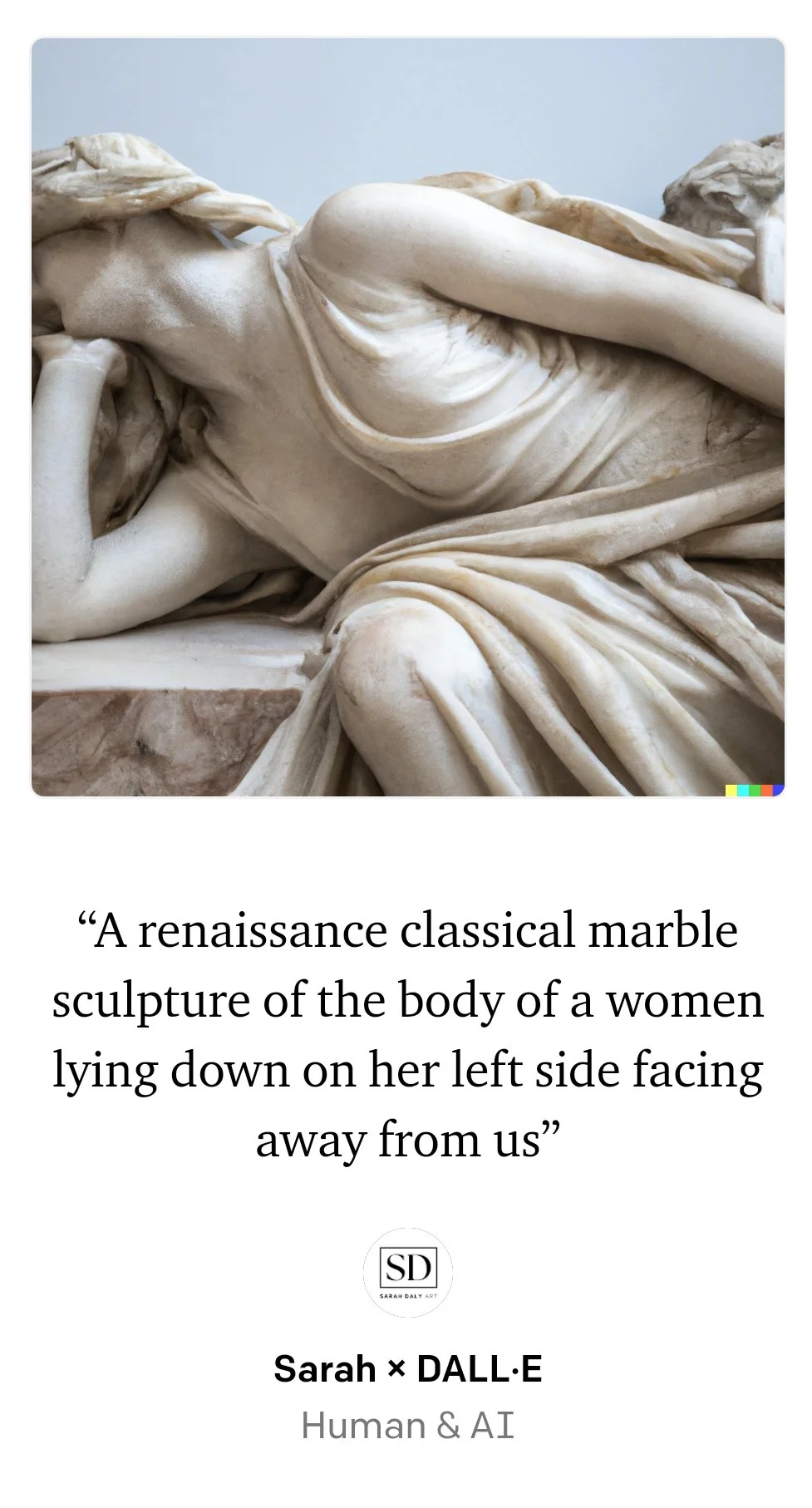Beauty and the Machine
The concept of beauty, as processed and interpreted by artificial intelligence (AI), does not typically fall within the scope of traditional AI research, which often focuses more on capabilities, functionalities, and applications of AI systems rather than aesthetic judgments. Given the rise of generative AI and creative machines, I feel like this is an important direction to investigate. This article starts to discuss some of my thinking.
There are already authors and researchers who explore intersections between AI and aesthetics, including the processing and creation of beauty, though these discussions might not always directly address "how AI processes the concept of beauty" in a philosophical sense. Instead, they tend to approach the subject from the perspectives of AI's ability to generate aesthetically pleasing outputs or to analyze and replicate patterns identified as beautiful by humans. Here are a few areas where the discussion around AI and beauty can be found:
Computational Aesthetics
Researchers in computational aesthetics and computer science aim to understand and replicate human aesthetic judgments using AI. This field involves algorithms that can evaluate and create artworks, music, and designs that humans might find beautiful. While these studies often focus on technical capabilities, they implicitly touch on how AI "understands" or processes beauty by mimicking human aesthetic preferences.
AI in Art and Design
Authors and commentators in the domain of AI-generated art and design often discuss how AI tools like DeepDream, GANs (Generative Adversarial Networks), and others are used to create visually striking and aesthetically pleasing artworks. These discussions sometimes delve into the nature of beauty as interpreted or generated by AI, focusing on the outcomes of AI processes rather than on AI's conceptual understanding of beauty. Here is one of my favorite articles, written by an art historian and an AI researcher: Art, Creativity and the Potential and Artificial Intelligence.
Philosophy of AI
Philosophers and ethicists interested in AI occasionally ponder the implications of AI's role in aesthetics, asking whether AI can truly appreciate beauty or if it merely replicates patterns associated with beauty as recognized by humans. While direct discussions might be sparse, works in this area explore the broader questions of mind, consciousness, and subjective experience in relation to AI.
While not exclusively focused on the concept of beauty, authors like Margaret Boden have touched upon creativity and aesthetics in the context of AI, which can be extrapolated to discussions around beauty. Similarly, works by Arthur I. Miller, particularly those exploring the creative aspects of AI in art, lean towards the generation and interpretation of beauty through artificial means.
Testing how DALLE 2 perceives concepts we often recognise as beautiful
I was doing some test images to think through a new series I’m working on, talking to concepts on Renaissance art and creative AI. I am referencing classical sculptures in this series, and wanted to see how DALLE interpreted some classical ideals of beauty. I tried reinterpreting the Venue de Milo, but DALLE’s usage policies come up. While I’m not clear which policy the Venue de Milo relates to (I’m thinking it is nudity, which is a whole different conversation), I decided to go for a more modern interpretation and asked for “Bella Hadid as a full length classical sculpture in white marble”.
The understanding of beauty between humans and artificial intelligence (AI) involves fundamentally different processes due to the nature of human consciousness, subjective experiences, and the algorithmic basis of AI. Here's a comparison of the key differences.
Basis of Understanding
Humans: Human understanding of beauty is deeply subjective, influenced by emotional responses, cultural backgrounds, personal experiences, and biological factors. Humans can experience beauty viscerally and emotionally, often without fully conscious reasoning.
AI: AI "understands" beauty based on algorithms, data analysis, and patterns it has been trained on. Its process is objective, relying on predefined criteria and patterns derived from large datasets, including images, texts, and other forms of data that exemplify human-defined concepts of beauty.
Emotional and Conscious Experience
Humans: Emotional depth and conscious experience play a critical role in how humans perceive and appreciate beauty. The emotional response to beauty is complex and can be influenced by memories, personal significance, and even the mood of the observer.
AI: AI lacks consciousness and emotional depth. While AI can simulate responses to beauty based on patterns and data, it does not experience emotions or conscious thought. Any "appreciation" is a mimicry of human responses, devoid of subjective experience.
Cultural and Social Influences
Humans: Cultural and social contexts significantly shape human perceptions of beauty. These influences are dynamic and evolve over time, reflecting changes in societal values, cultural trends, and historical contexts.
AI: AI can be programmed to recognize and replicate patterns that reflect cultural standards of beauty, but its understanding is static and based on the data it was trained on. It does not naturally evolve with changing cultural norms unless its datasets are updated or retrained to reflect these changes.
Creativity and Innovation
Humans: Human creativity in the perception and creation of beauty involves intuition, innovation, and the ability to make leaps of imagination. Humans can create and recognize beauty in unexpected places, often breaking from established patterns.
AI: AI can generate novel combinations and creations based on its training, which can sometimes mimic creativity. However, AI's "creativity" is bound by the scope of its programming and the data it has analyzed. It lacks the ability to truly innovate or think abstractly beyond its algorithms.
Personal and Subjective Nuances
Humans: Individual preferences play a significant role in how beauty is perceived by humans. These preferences can be idiosyncratic and vary widely even within the same cultural and social contexts.
AI: AI's understanding of beauty is generalized and based on aggregate data. While it can be tailored to mimic individual preferences to a certain extent, it does not possess personal tastes or experiences that shape its perceptions.
The human perception of beauty is a rich and complex experience influenced by emotional, cultural, and personal factors. In contrast, AI's approach to beauty is objective, data-driven, and - for now - lacks the depth of consciousness and emotional engagement that characterizes human interaction with beauty. AI can replicate or simulate an understanding of beauty based on patterns and data it has been trained on, but it does not "understand" beauty in the human sense of experiencing emotional resonance or subjective appreciation.
Conclusion
Direct discussions by authors on how AI processes the concept of beauty are more nuanced and embedded within broader topics of AI's role in art, design, and creativity. As AI continues to evolve and play a significant role in creative fields, the dialogue around AI and beauty is likely to expand, potentially offering new perspectives and understandings in the future. For me, the bridge between AI, aesthetics, and philosophy is a fascinating space for investigation. I feel like the contrast in how machines and humans process beauty gives us something to push against in terms of thinking though what beauty even is, and why it exists.
I’ve just released AERIAL, a new series of designer art prints which brings the beauty of nature into your world. The original pieces were created in collaboration with AI, then hand-painted in traditional oils and beeswax on linen canvas. They were then scanned in a ridiculously high resolution and are printed on archival cotton rag or canvas. You can view and purchase them in my shop.
The Moments That Become Us [SQ3], AERIAL Series, Sarah Daly (2023)



